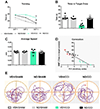Nandrolone Abuse Prior to Head Trauma Mitigates Endoplasmic Reticulum Stress, Mitochondrial Bioenergetic Deficits, and Markers of Neurodegeneration
- PMID: 39313656
- PMCID: PMC12320952
- DOI: 10.1007/s12035-024-04488-8
Nandrolone Abuse Prior to Head Trauma Mitigates Endoplasmic Reticulum Stress, Mitochondrial Bioenergetic Deficits, and Markers of Neurodegeneration
Abstract
The abuse of synthetic steroids, such as nandrolone decanoate (ND), is often associated with violent behavior, increasing the risk of traumatic brain injury (TBI). After a TBI, proteins like APP, β-amyloid peptide-42 (Aβ42), and phosphorylated tau (pTau) accumulate and trigger endoplasmic reticulum (ER) stress associated with an unfolded protein response (UPR). The involvement of mitochondrial bioenergetics in this context remains unexplored. We interrogate whether the abuse of ND before TBI alters the responses of ER stress and mitochondrial bioenergetics in connection with neurodegeneration and memory processing in mice. Male CF1 adult mice were administered ND (15 mg/kg) or vehicle (VEH) s.c. for 19 days, coinciding with the peak day of aggressive behavior, and then underwent cortical controlled impact (CCI) or sham surgery. Spatial memory was assessed through the Morris water maze task (MWM) post-TBI. In synaptosome preparations, i) we challenged mitochondrial complexes (I, II, and V) in a respirometry assay, employing metabolic substrates, an uncoupler, and inhibitors; and ii) assessed molecular biomarkers through Western blot. TBI significantly increased APP, Aβ42, and pTauSer396 levels, along with ER-stress proteins, GRP78, ATF6, and CHOP, implying it primed apoptotic signaling. Concurrently, TBI reduced mitochondrial Ca2+ efflux in exchange with Na+, disturbed the formation/dissipation of membrane potential, increased H2O2 production, decreased biogenesis (PGC-1⍺ and TOM20), and ATP biosynthesis coupled with oxygen consumption. Unexpectedly, ND abuse before TBI attenuated the elevations in APP, Aβ42, and pTauSer396, accompanied by a decrease in GRP78, ATF6, and CHOP levels, and partial normalization of mitochondrial-related endpoints. A principal component analysis revealed a key hierarchical signature featuring mitochondrial Ca2+ efflux, CHOP, GRP78, TOM20, H2O2, and bioenergetic efficiency as a unique variable (PC1) able to explain the memory deficits caused by TBI, as well as the preservation of memory fitness induced by prior ND abuse.
Keywords: Abuse; Nandrolone; Traumatic brain injury.
© 2024. The Author(s), under exclusive licence to Springer Science+Business Media, LLC, part of Springer Nature.
Conflict of interest statement
Declarations. Conflict of Interest: The authors declare no competing interests.
Figures







References
MeSH terms
Substances
Grants and funding
LinkOut - more resources
Full Text Sources
Medical
Research Materials
Miscellaneous

